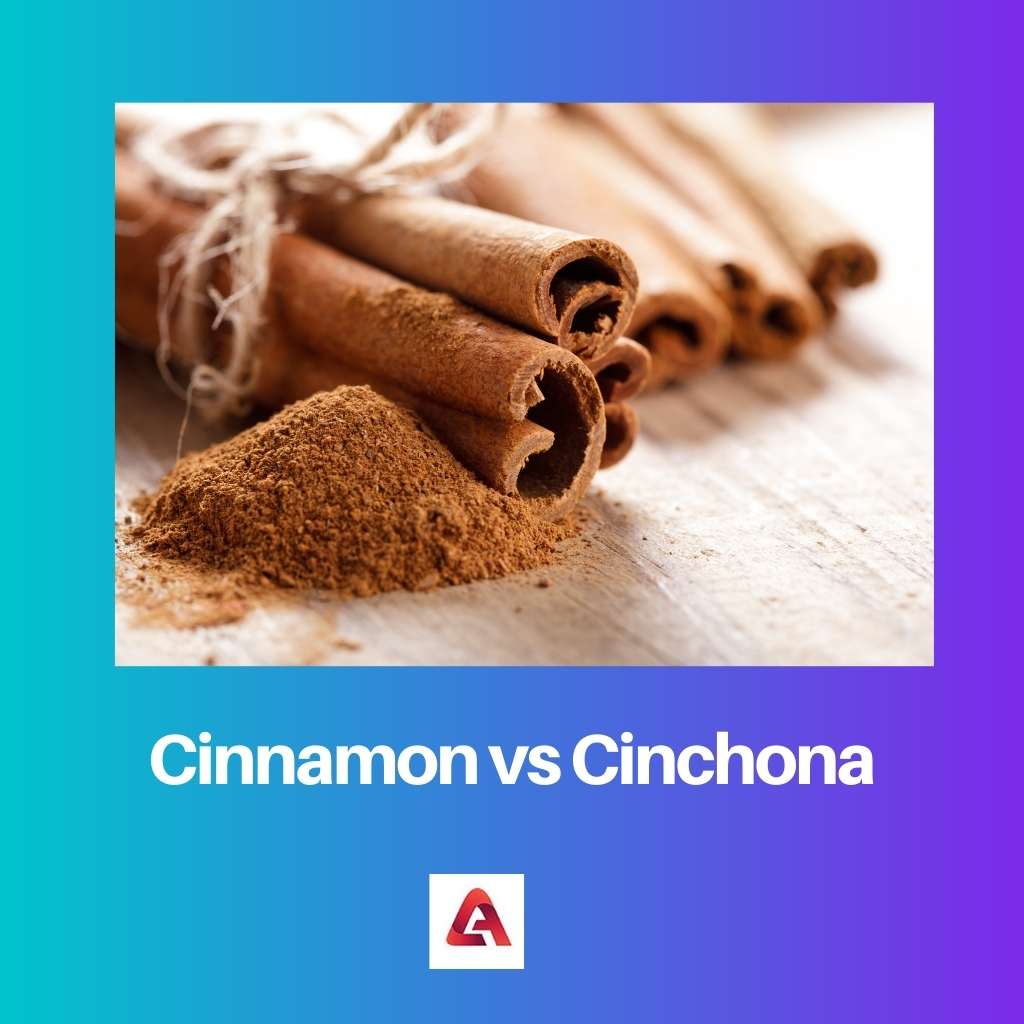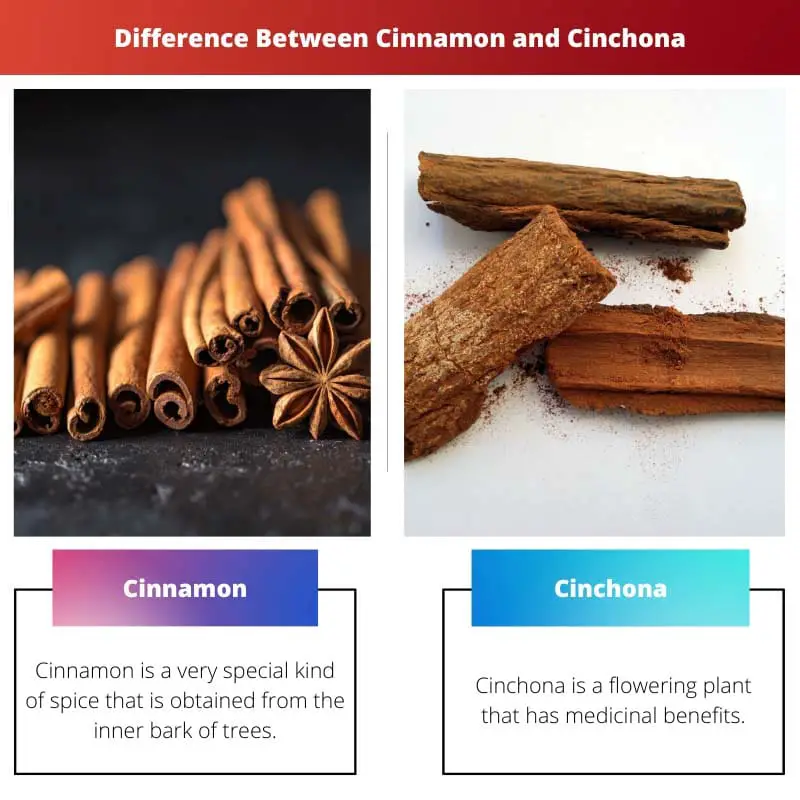There are several spices, herbs, flavoring agents, flowers, and plant extracts that are used in our daily lives for various purposes.
These items are either used for flavoring purposes (like spices and herbs) or medicinal purposes (like flowers and plant extracts). Cinnamon and cinchona fall in the two categories described above respectively.
Key Takeaways
- Cinnamon is a popular spice derived from the bark of trees in the Cinnamomum family, while cinchona is a plant from which the antimalarial compound quinine is extracted.
- Cinnamon has a sweet, warm flavor and is used in various culinary applications, while cinchona is primarily used for medicinal purposes.
- Cinchona bark contains alkaloids that can cause side effects when consumed in large quantities, whereas cinnamon is safe for consumption in moderate amounts.
Cinnamon vs Cinchona
The difference between cinnamon and cinchona is that the former is a spice that adds flavor to food items. On the other hand, the latter is a medicinal flower. Cinnamon and cinchona belong to different families, genera, orders, and tribes. Both the items are very different from each other.

Cinnamon is a very special kind of spice that is obtained from the inner bark of trees. It is famous for its anti-diabetic specialty and helps lower blood sugar levels.
Cinnamon is used in a varsity of dishes, desserts, stews, gravies, and other food items to enhance their tastes and textures.
Cinchona is a flowering plant that has medicinal benefits. It can easily fight against the disease Falciparum malaria which has gained resistance again other strong medicinal drugs.
Cinchona belongs to the Rubiaceae family and kingdom Plantae. It is also referred to as Quina. This flowering plant is quite famous in different parts of the world.
Comparison Table
| Parameters Of Comparison | Cinnamon | Cinchona |
|---|---|---|
| Family | The name of the family of cinnamon is Lauraceae. | the name of the family of cinchona is Rubiaceae. |
| Major Chemical Constituent | Cinnamaldehyde is the major chemical constituent present in cinnamon. | Alkaloid is the major and most important chemical constituent present in cinchona. |
| Uses | It mainly fixes gastrointestinal problems and diarrhea. | It increases one’s appetite and reduced bloating and feeling of fullness. |
| Species | C.verum is the only species of cinnamon. | Cinchona has 23 species in total. |
| Order | The name of the order of cinnamon is Laurales. | Gentianales is the name of the order of cinchona. |
What is Cinnamon?
Cinnamon is a flavoring agent and aromatic spice that is used in several dishes, sweet dishes, savories, cereals, tea, traditional food items, desserts, snack foods, etc.
It is obtained and produced from the inner bark layer of several trees that belong to different species but belong to the same genus that is Cinnamomum. This spice has several species but only a few of them are used as spicing agents.
Cinnamon has a shelf life or life expectancy of 3 years to 4 years. This spice can easily be substituted with a variety of other spicing agents like:
- Allspice
- Nutmeg
- Apple Pie spice (it contains a certain amount of cinnamon in it)
- Cloves
Cinnamon is used in several dishes. A few of such dishes are listed below:
- Cinnamon rolls
- Morning buns and hot cross buns
- Cookies (like baklava, snicker doodles, and rugelach)
- French toast
- Rice pudding
- Pumpkin pie, apple pie, and sweet potato pie
- Apple desserts (baked apples, apple crisps, apple pie, and apple crumbles)
Cinnamon has several benefits and advantages. A few of such benefits and advantages are listed below:
- It has anti-fungal, anti-viral, and anti-bacterial properties.
- It improves and enhances one’s gut health.
- Cinnamon manages the blood pressure and lowers the blood sugar level.
- It helps in enhancing and improving the brain’s health.
- This spice fights and avoids type-2 disease.

What is Cinchona?
Cinchona is a flowering plant that includes a total of 23 species under it. This flowering plant belongs to the Rubiaceae family and is obtained from small trees or large shrubs grown in South America.
The bark is known for several properties and is known as the Jesuit’s bark or Peruvian bark.
Cinchona is used in a variety of food items. A list of such food items are listed/ given below:
- Tonic water
- Lemon juice
- Bitter lemon-flavored soft drinks
Cinchona is used in several medicinal capsules that are supplied to hospitals by various manufacturing companies. This medicinal plant contains quinine that helps fight falciparum malaria.
It also contains quinidine that treats heart palpitations or arrhythmias.
Cinchona serves us with several advantages. A few of these advantages and benefits are:
- It helps fix bloating and a feeling of fullness.
- Cinchona releases digestive juices to increase and improve one’s appetite.
- It cures and treats various blood vessel problems like varicose veins, leg cramps, and hemorrhoids.
- The flowering plant also helps cure and treat malarial diseases.
- It is widely used among people to improve their hair condition and increase hair growth.
Cinchona shouldn’t be consumed in large quantities as it causes several diseases. These diseases could range from nausea to severe diarrhea. There should be a cautious use of this flowering plant.

Main Differences Between Cinnamon and Cinchona
- Cinnamon is a spice and has a shelf life of 3 to 4 years while on the other hand, cinchona is a flowering plant and has a shelf life of 1 year or more.
- Cinnamaldehyde is the main chemical constituent of cinnamon while on the other hand, alkaloid is the major chemical content of cinchona.
- Cinnamon has a single species while on the other hand, cinchona has 23 different species.
- Lauraceae is the name of the family of cinnamon while on the other hand, Rubiaceae is the name of the family of cinchona.
- Cinnamon majorly fixes bacterial, viral, and fungal problems while on the other hand, cinchona fixes malarial problems.

- https://scholar.google.com/scholar?hl=en&as_sdt=0%2C5&q=Cinnamon&btnG=#d=gs_qabs&u=%23p%3DeMnSeP7MPOQJ
- https://scholar.google.com/scholar?hl=en&as_sdt=0%2C5&q=Cinchona&btnG=#d=gs_qabs&u=%23p%3DPEpKn2AWF6wJ
